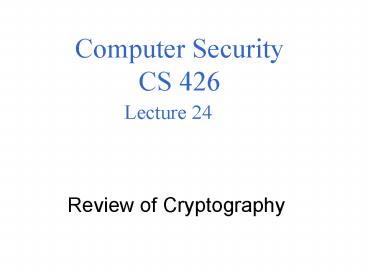Computer Security CS 426 Lecture 24 - PowerPoint PPT Presentation
1 / 12
Title:
Computer Security CS 426 Lecture 24
Description:
depending on whether common strings are encrypted and the mode ... mode. not vulnerable under CBC mode with ... Fail-safe defaults: in RBAC default is no access ... – PowerPoint PPT presentation
Number of Views:40
Avg rating:3.0/5.0
Title: Computer Security CS 426 Lecture 24
1
Computer Security CS 426Lecture 24
- Review of Cryptography
2
Review of Cryptography Symmetric Encryption
- Classical ciphers are broken under
ciphertext-only attacks - One-time pad has perfect secrecy, but is
difficult to use in practice - Stream ciphers (RC5) approximate one-time pad
- fast, but difficult to use correctly
- avoid reusing the same key stream
- Block ciphers DES, AES
- Block cipher encryption modes
- ECB is deterministic
- should use CBC with random IV
3
Review of Cryptography Asymmetric Encryption and
Hash
- RSA CMe mod n. MCd mod n.
- security relies on factoring,
- 700-bit n broken today, 1024 likely crackable by
2010, at least 2048 to be kept secure for 2030 - Hybrid encryption
- To encrypt M, get (ke mod n, AES-CBCkM)
- Cryptographic hash functions
- preimage resistant, second preimage resistant,
collision resistant - birthdat attack
- MD5 (128, broken), SHA-1 (160, partially broken),
SHA-2 (256, 384, 512)
4
Review of Cryptography Message Authentication
and Key Agreement
- MAC CK(M), can be computed only when knowing k
- can be constructed using hash function or block
cipher - Digital signatures
- to sign M using RSA, computes h(M)d mod n
- Public key certificates
- Entity authentication storing passwords (salts),
hash-chain based one-time passwords, challenge
response - Diffie-Hellman key agreement
- Needham-Schroeder shared-key and public-key
protocol - trusted third party (online and offline)
5
HW3 Problem 1
- Substituion cipher
- ciphertext-only frequency analysis
- known-plaintext recover the substitution
- Chosen plaintext attack against DES
- for each key k
- add ltEkM0, kgt to a table sorted based on the
first element - end
- when given C, a ciphertext of M0 under unknown
key - search for C in the table, and find the
corresponding key(s)
6
HW3 Problem 1 (continued)
- Effectiveness
- known-plaintext
- depending on whether common strings are encrypted
and the mode - known-plaintext with common strings
- vulnerable under ECB mode
- not vulnerable under CBC mode with random IV
7
HW3 Problem 2 Life of AES
- Weakness of algorithm
- likely no weakness in 50 years and more
- no weakness of DES in 30 years, AES designed with
much better understanding of block cipher - Vulnerablity to exhaustive search
- assumes that 70-bit can be broken today
- assumes every year can break 2 more bits, then
128 can last 28 years and 256 can last 93 years - Moores law says every year can break 2/3 more
bits - Quantum computers
- takes 2n/2 to search 2n
- unlikely to be of threat in next 50 years
8
HW3 Problem 3
- Alice poses math problem to Bob
- known as cryptography commitment
- requires two security requirements (hiding and
binding) - Stealing password file
- preimage resistance
- Hashing system binary files
- second preimage resistance
- Coming up with new messages for old signatures
- second preimage resistance
- New signatures
- collision resistance (which implies the other two)
9
HW3
- Problem 4
- Replace both Alice and Bobs public keys with the
attackers public key - Problem 5
- create an account and use the cookie to try to
log into another account, using your own password - how to store correctly?
10
HW3 Problem 7
- Separation of privilege
- can use statically mutually exclusive roles
- can be violated when permissions are incorrectly
assigned - Least privilege
- roles help assign only the minimal needed
permissions - hierarchy and constraints on role activation help
limit permission sin each session - require correct configuration
- allow multiple role activation means constraints
are explicitly needed to support least privilege
11
HW3 Problem 7
- Economy of mechanism RBAC is simple, but can
require a lot of extensions to support desirable
properties - Fail-safe defaults in RBAC default is no access
- Complete mediation an enforcement issue, RBAC is
about policy specification - Open design yes
- Least common mechanism not relevant
- Psychological acceptability basic RBAC matches
how one thinks about permission management
12
Coming Attractions
- November 20
- Web browser security issues































